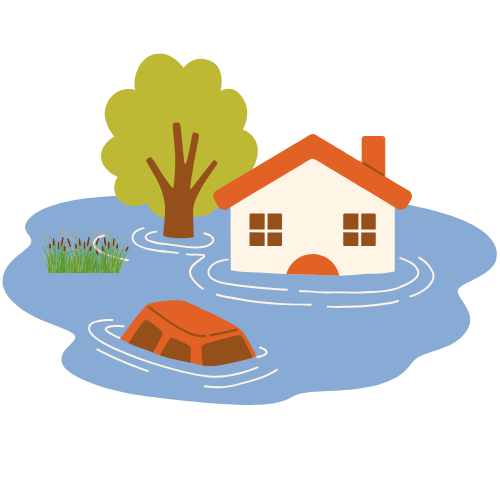Dealing with Stormwater and Flooding on Your Property

Flooding and drainage issues can be frustrating and sometimes overwhelming. Jackson Soil and Water Conservation District (JSWCD) does not manage stormwater systems or enforce drainage regulations, but we can help point you in the right direction. This page provides key information and contacts to help you address flooding concerns.
Additionally, here is a helpful contact list for questions regarding creeks,
water rights, impacts to riparian vegetation, and stormwater in Jackson and Josephine Counties:
1. Determine Your Location
Your first step is to figure out whether your property is within a city limit, managed by a utility district, or in an unincorporated area of Jackson County.
- Use this interactive map to check your property’s location:
Jackson County GIS Map
2. Who to Contact
If You Are Within a City Limit
Contact your city’s public works or stormwater department.
Example:
- City of Medford Stormwater Program
Medford Stormwater Program Website
Phone: (541) 774-2100
If You Are in White City, Eagle Point, or Nearby Areas
Rogue Valley Sewer Services (RVSS) manages stormwater in several jurisdictions.
- Phone: (541) 664-6300
- RVSS Website
If You Are Outside City Limits (Unincorporated Jackson County)
You may not be within a formal stormwater jurisdiction and likely fall under Oregon Drainage Law.
- Review the Oregon Drainage Law Guidelines (PDF)
If flooding is related to a nearby county road:
- Jackson County Roads Department
Phone: (541) 774-8184
If You Are Downhill from an Irrigation District
Flooding may result from a leak or breach in an irrigation system. Contact the appropriate irrigation district for assistance. A link to contact information for local irrigation districts is provided at the bottom of this page.
3. Important Safety and Legal Considerations
- Never try to unclog a culvert during high water. This is extremely dangerous. Call a professional and wait until floodwaters recede.
- Talk to your neighbors—especially those uphill or downhill—before doing any work that might change the way water flows on or off your property. Many drainage problems start with construction that unintentionally alters natural flow patterns.
- Refer to Oregon Drainage Law when making any changes to drainage on your property.
4. Stream and Vegetation Maintenance Guidelines
- It is OK to remove non-woody vegetation (like cattails) that may be clogging small drainages.
- Do NOT remove woody debris or excavate in streams below the Ordinary High Water Mark unless you have a plan in place.
- If trees or shrubs need to be removed from a stream, contact ODFW (Oregon Department of Fish and Wildlife) to develop a replacement and mitigation plan.
5. Additional Tips and Reminders
- Flooding is a natural process. Even with preventative measures, flooding can and will happen again in the future.
- Document the damage. Take plenty of pictures during and after the flood for your records or potential assistance.
- In major flooding events, if infrastructure maintained by an organized entity (like an irrigation district) is damaged, FEMA may provide funding for repairs. Keep detailed documentation.
If you have questions or need help identifying the right contact, feel free to call us at (541) 423-6159 and we’ll do our best to assist you.

.png?ixlib=rb-1.1.0&or=0&w=720&h=720&fit=max&auto=format%2Ccompress&s=29e7ed5f50ccc977734ed0690d3dc937)
